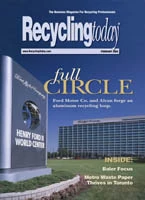CMRA DISCUSSES NEW ENGLAND LAWS
The New England Chapter of the Construction Materials Recycling Association (CMRA) discussed several topics at a November meeting in Hampton, N.H.
Regulators from Connecticut, Maine, Massachusetts, New Hampshire and Vermont were part of a panel discussion on C&D issues in New England, with most area C&D recyclers in attendance.
Presentations provided insight on complicated C&D situations. For example, James McQuade of the Massachusetts Department of Environmental Protection (DEP) reported that his state generated 4.4 million tons of C&D materials each year, with about 3 million being asphalt, brick and concrete (ABC). About 56 percent of the C&D material is recycled, but only 3 percent of that is mixed C&D, with the ABC being the bulk.
These numbers present a problem, as a legislative ban on unprocessed C&D entering the state’s landfills will begin late next year, and markets are undeveloped. In addition, like all New England states, Massachusetts does not recognize the wood fuel market as recycling.
New Hampshire has almost as much C&D waste coming into it (175,000 tons) as it generates (250,000 tons), Chris Way of the New Hampshire Department of Environmental Services (NHDES) said. As in the rest of New England, C&D wood used as mulch and the sale of demolition wood chips into the wood fuel market are restricted.
James "Buzz" Surwilo of the Vermont Department of Environmental Conservation said his state has been promoting waste reduction. Its only C&D landfill is closing shortly, and the next one is not expected online until late 2003 at the earliest. Currently, any 10,000-square-feet or larger construction project must have a conditional permit outlining the project’s recycling plan and its implementation.
Much of the current wood fuel market feeds boilers in Maine, which is looking more closely at the content of fuel stocks, says Randy McMullin of the Maine DEP. Maine will focus on PCBs and arsenic. Currently in Maine, a power-generating facility can burn as much as 50 percent C&D wood before a solid waste permit is required to operate.
Connecticut has a special dichotomy for C&D, the DEP’s Frank Gagliardo said: construction debris is considered municipal solid waste (MSW), while demolition debris is classified as bulky waste. In 2000 the state generated 690,000 tons of C&D debris, with 357,000 tons volume-reduced; 41,000 tons made into new products; and 300,000 tons disposed of. But a substantial amount of the state’s C&D debris is not represented in this count, as it is shipped directly from the jobsite into Pennsylvania, where tipping fees are lower.
John Blaisdell and Greg Wirsen of Green Seal Environmental, leaders of the New England Chapter, organized the meeting.

Explore the February 2003 Issue
Check out more from this issue and find your next story to read.
Latest from Recycling Today
- RRS adds to ownership team
- S3 Recycling Solutions acquires Electronics Recycling Solutions
- Nextek, Coveris to recycle food-grade plastic film
- Recyclekaro expands recycling capacity
- USTR hears comments on port fee proposal
- C&D World 2025 hits record attendance and exhibitor numbers
- Denali now offers mobile depackaging service
- Hyundai confirms Louisiana as EAF mill site





